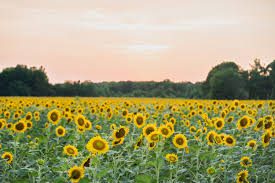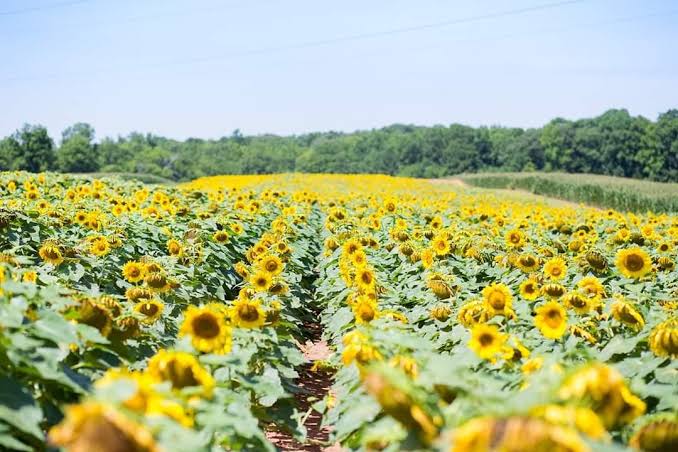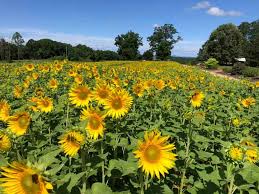Sunflower field is a magical place where the golden blooms stretch towards the sky, creating a sea of yellow brilliance. As the sun rises, the petals slowly unfurl, reaching for the warmth and light. These cheerful flowers, with their vibrant hues, dance in the gentle breeze, creating a symphony of color that captivates the heart.
In a sunflower field, every blossom tells a story of resilience and growth. From tiny seeds buried in the soil, they sprout into tall, sturdy stems that proudly bear the weight of the radiant blooms. The journey from seed to sunflower is a testament to nature’s remarkable ability to transform the simplest beginnings into breathtaking beauty.
As you walk through the sunflower field, the earthy scent of the soil mingles with the sweet perfume of the flowers, creating an intoxicating aroma that envelops the senses. Bees and butterflies flit from one sunflower to another, pollinating and ensuring the cycle of life continues in this vibrant ecosystem.
The sunflower field is not just a feast for the eyes but also a sanctuary for various creatures. Birds find refuge in the tall stalks, their melodious songs harmonizing with the rustling of leaves. The field is alive with the gentle hum of life, a harmonious blend of nature’s symphony.
During the day, the sunflower field becomes a haven for those seeking solace and inspiration. The swaying flowers seem to whisper tales of optimism, reminding all who wander through that, like them, we too can turn towards the light and thrive. The sheer expanse of yellow creates a sense of serenity, inviting contemplation and reflection.
As the sun begins its descent, casting a warm glow across the landscape, the sunflower field transforms into a canvas of golden hues. The setting sun kisses each petal, casting long shadows that paint the field in a mesmerizing palette of oranges and reds. It’s a sight that etches itself into the memory, a moment frozen in time.
Even as the day bids farewell, the sunflower field doesn’t lose its allure. The night brings a different kind of beauty as the moonlight bathes the blooms in a soft, silvery glow. The field becomes a dreamscape, a place where fantasies take root amidst the slumbering flowers.
In the simplicity of a sunflower field, one discovers the profound beauty of nature’s rhythm. It’s a place where time seems to slow, allowing the soul to connect with the earth and the sky. Each visit to a sunflower field is a reminder that, in the vast tapestry of existence, the simplest things can leave the deepest impressions.
Read Also: Cavapoos: Description, Health, Origin and Complete Care Guide
Growing and Care Guide of Sunflower Field

Growing sunflowers can be a rewarding experience, and with proper care, you can cultivate these cheerful blooms to their full potential.
1. Planting: Begin by selecting a sunny location with well-drained soil. Sunflowers thrive in full sunlight, so choose a spot that receives at least 6-8 hours of sunlight daily. Plant the seeds directly into the soil, sowing them about 1 to 1.5 inches deep and spacing them according to the specific variety’s recommendations.
2. Watering: Sunflowers have a moderate water requirement, especially during their early growth stages. Water the plants consistently but avoid overwatering, as sunflowers don’t tolerate waterlogged soil. Once established, they are relatively drought-tolerant, but regular watering can promote healthier and more robust growth.
3. Soil Fertility: Sunflowers prefer well-draining soil with a slightly acidic to neutral pH. Before planting, amend the soil with organic matter to enhance fertility. A balanced fertilizer can be applied during the growing season, but avoid excessive nitrogen, as it may encourage lush foliage at the expense of flower production.
4. Support and Staking: Tall sunflower varieties may benefit from support or staking to prevent them from bending or toppling over in strong winds. Install stakes or a support structure early in the growth stages, being careful not to damage the roots.
5. Weeding: Regular weeding is essential to keep the sunflower bed free from competing plants. Weeds can rob the soil of nutrients and water, affecting the sunflowers’ growth. Mulching around the base of the plants can also help suppress weeds and retain soil moisture.
6. Pest Control: Keep an eye out for common pests such as aphids or caterpillars, which may target sunflowers. Insecticidal soap or neem oil can be effective and environmentally friendly solutions for pest control. Inspect the plants regularly to catch any issues early.
7. Harvesting: Sunflowers typically bloom in late summer to early fall. Harvest the flowers once the petals have fully opened, and the center disk has developed. Cut the stems at an angle, leaving a few sets of leaves attached. Allow the cut flowers to dry in a well-ventilated area, and you can save the seeds for planting next season or for a tasty snack.
8. Fall Cleanup: After the growing season, remove any remaining plant debris to reduce the risk of pests and diseases overwintering in the garden. Consider leaving some spent sunflower heads in the garden during winter, as they can provide food for birds.
Read Also: American Bullies: Description, Health, Origin and Complete Care Guide
Importance of Sunflower Field

The importance of a sunflower field extends across various aspects, combining ecological, agricultural, aesthetic, and cultural significance.
1. Ecological Importance: Sunflower fields act as vibrant ecosystems, attracting pollinators such as bees and butterflies. The blossoms provide nectar and pollen, supporting the pollination of surrounding plants. The field becomes a habitat for diverse insects, contributing to overall biodiversity.
2. Agricultural Significance: Sunflower fields are cultivated for their valuable seeds, rich in oil and nutrients. Sunflower oil extracted from these seeds serves both culinary and industrial purposes, contributing to the global economy. The cultivation of sunflowers also offers farmers a versatile and economically viable crop option.
3. Soil Health and Conservation: The deep root system of sunflowers helps improve soil structure. Their extensive roots break up compacted soil, promoting aeration and water absorption. Sunflower fields, when used in crop rotation, contribute to sustainable agriculture by preventing soil degradation and erosion.
4. Aesthetic Beauty: Sunflower fields are visually striking, creating landscapes of golden brilliance. The sheer expanse of yellow flowers captivates the eye and offers a sense of serenity and beauty. This aesthetic value attracts visitors, providing a space for recreation and appreciation of nature’s splendor.
5. Cultural Symbolism: Sunflowers hold cultural significance as symbols of positivity, resilience, and warmth. Their inclusion in art, literature, and folklore reinforces their role as representations of joy and optimism. Sunflower fields, in particular, evoke a sense of wonder and happiness, becoming iconic in cultural narratives.
6. Tourism and Recreation: Sunflower fields often become tourist attractions, drawing visitors who seek the experience of wandering through seas of golden blooms. The visual appeal of sunflower fields contributes to tourism, providing a unique and picturesque backdrop for photography, relaxation, and outdoor activities.
7. Educational Opportunities: Sunflower fields offer educational value, providing opportunities for schools, nature centers, and communities to teach about plant life cycles, ecology, and sustainable agriculture. Hands-on experiences in caring for and observing sunflowers enhance environmental awareness and appreciation.
In addition, a sunflower field’s importance transcends mere aesthetics. It plays a vital role in ecological balance, sustainable agriculture, cultural symbolism, and provides a space for both recreation and education. The sunflower field stands as a testament to the interconnectedness of nature and its multifaceted contributions to our world.
Where to find Sunflower field near Me/You

Sunflower fields can be found in various regions, depending on climate and agricultural practices. Here are some common places where you might find or locate sunflower fields:
1. Agricultural Areas: Sunflowers are often cultivated in agricultural regions where they are grown as a crop. Fields of sunflowers can be found in rural areas, especially in regions with favorable growing conditions and large expanses of farmland.
2. Sunflower Farms: Many farmers specialize in cultivating sunflowers, and some operate sunflower farms. These farms may open to the public during the blooming season, allowing visitors to explore and enjoy the beauty of the sunflower fields.
3. Wildflower Meadows: In some regions, sunflowers may grow naturally in wildflower meadows. These areas can be found in both rural and more natural settings, providing a less cultivated but equally charming view of sunflowers.
4. Botanical Gardens: Some botanical gardens feature sunflower displays or dedicated areas where these flowers are grown. These curated spaces often showcase different sunflower varieties and may be accessible to the public.
5. Public Parks and Gardens: Occasionally, public parks and gardens may plant sunflowers for ornamental purposes. These areas can be a more accessible and urban location to find sunflowers in bloom.
6. Tourist Destinations: In certain regions, sunflower fields become popular tourist attractions during the blooming season. Tour operators may organize visits to these fields, providing an opportunity for travelers to experience the beauty of expansive sunflower landscapes.
7. Seasonal Festivals: Some areas host sunflower festivals during the blooming season. These events often coincide with the peak flowering period and may include activities such as guided tours, photography opportunities, and local crafts.
8. Social Media and Online Resources: Keep an eye on social media platforms and online resources. Some sunflower enthusiasts share the locations of particularly beautiful or accessible sunflower fields, allowing others to plan visits.
Remember, the timing of the visit is crucial. Sunflowers typically bloom in late summer to early fall, so plan your visit during this period for the best experience. Always respect private property and local regulations when exploring sunflower fields.
Read Also: Importance of Water Purification to Public Health and Safety
